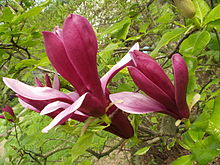Our website is made possible by displaying online advertisements to our visitors.
Please consider supporting us by disabling your ad blocker.
Magnolia liliiflora
| Magnolia liliiflora | |
|---|---|

| |
| Scientific classification | |
| Kingdom: | Plantae |
| Clade: | Tracheophytes |
| Clade: | Angiosperms |
| Clade: | Magnoliids |
| Order: | Magnoliales |
| Family: | Magnoliaceae |
| Genus: | Magnolia |
| Subgenus: | Magnolia subg. Yulania |
| Section: | Magnolia sect. Yulania |
| Subsection: | Magnolia subsect. Yulania |
| Species: | M. liliiflora
|
| Binomial name | |
| Magnolia liliiflora | |
| Synonyms[1] | |
| |
Magnolia liliiflora is a small tree native to southwest China (in Sichuan and Yunnan), but cultivated for centuries elsewhere in China and also Japan. Variously known by many names, including Mulan magnolia, purple magnolia, red magnolia, lily magnolia, tulip magnolia and woody-orchid, it was first introduced to English-speaking countries from cultivated Japanese origins, and is thus also sometimes called Japanese magnolia, though it is not native to Japan. It is now also planted as an ornamental in North America and Europe, though rather less often than its popular hybrid (see below).
It is a deciduous shrub, exceptionally a small tree, to 4m tall (smaller than most other magnolias), and blooms profusely in early spring with large pink to purple showy flowers, before the leaf buds open. It is one of the slowest-growing trees, with a growth rate of 15 - 30 centimeters (6–12 in) when young.[2]
The cultivar 'Nigra', with flowers much deeper in colour than the species, has gained the Royal Horticultural Society's Award of Garden Merit.[3] It prefers an acid or neutral soil, in full sun or light shade.
This species is one of the parents of the popular hybrid saucer magnolia, M. × soulangeana, the other parent being the Yulan magnolia, M. denudata.

- ^ The Plant List: A Working List of All Plant Species, retrieved 29 May 2016
- ^ DeAngelis, Zack (2022-01-03). "Slowest Growing Trees (And Why They Grow So Slow) - Tree Journey". Retrieved 2023-09-21.
- ^ "Magnolia liliiflora 'Nigra'". Royal Horticultural Society. 2017. Retrieved 2017-01-23.
Previous Page Next Page






